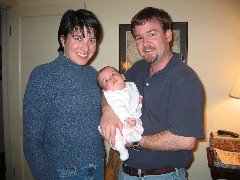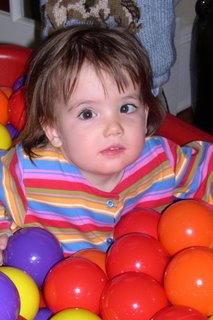
This blog is dedicated to discussing issues concerning children with special needs. I was inspired to begin writing this blog because of my daughter Roxie, who has special needs. This is Roxie’s story.
Our Family’s Blissful Beginnings
Roxie was born in November of 2002 in Charlotte, NC. She weighed a healthy 6 lbs. 14oz., received a 9 on her Apgar, and a passing grade on her hearing test. She was beautiful and nothing seemed the matter. No one foresaw the difficulties ahead.
Roxie was a fussy infant, but I wrote off her fussing as colic or teething. And I assumed her slow weight gain could was simply related to my novice abilities at breast-feeding or her small build. Roxie smiled for the first time at 6 weeks and she rolled over for the first time at 3.5 months. Everything seemed just fine. But when she was about 5.5 months old my husband said that he thought she had hit a plateau regarding her development. I disagreed and noted that many of my baby books and magazines indicated that all babies progress at different rates. At that time I felt her slow progress was OK that she’d develop soon enough.
The Bombshell: Your daughter has developmental delays…
Then, at her six month check-up the doctor dropped a bombshell. After her examination he told us Roxie is developmentally delayed and that she has hypotonia (low muscle tone). He lifted up her tiny body and pointed out how her head lagged behind. At the time this seemed like a small problem that I thought we could solve with physical therapy and exercise. But then the doctor mentioned that we should make an appointment with a neurologist. My heart stopped. What could he mean? Was something wrong with her brain? As her parents the next days were filled worry. We visited a pediatric neurologist in town and he ordered all kinds of tests to try to gain a diagnosis or a clue that might aid in treating Roxie’s condition. However some of the tests he ordered would indicate a possibly tragic diagnosis. I held my breath and hoped for the best. Thankfully all the tests all came back normal.
The Seizures Begin
Then a week after visiting the neurologist I saw Roxie’s first seizure episode. She was six and a half months old. I didn’t recognize it as a seizure the first time, but I was alarmed. I was changing Roxie’s diaper and she started throwing her arms up over and over every few seconds. The episode lasted about 30 seconds. Then later that night my husband went to check on Roxie in her crib and witnessed the same activity. We decided to call the pediatrician’s trauma line and realized, as we described the incident over the phone, what had happened. Roxie had a seizure.
Roxie was admitted to the hospital immediately for treatment and observation. She was hooked up to monitors and given anti-seizure medication, which made her lethargic and fussy. Over the next few days she remained connected to various monitors and equipment. The neurologist explained that she had infantile spasms. He couldn’t predict if they would return soon or ever again. But the future looked scary. We didn’t know what was happening to her brain during these seizures or why she was having them.
Treatments
We received a report that indicated the MRI scan of Roxie’s brain was abnormal. The bundle of nerves between the left and right hemispheres of her brain, called the corpus callosum, was described as
 thin. The MRI report also noted that there were abnormal levels of white matter and there was a small area, called a heterotopia, noted as abnormal cells. It wasn’t clear to me what any of this meant or what Roxie’s future held.
thin. The MRI report also noted that there were abnormal levels of white matter and there was a small area, called a heterotopia, noted as abnormal cells. It wasn’t clear to me what any of this meant or what Roxie’s future held.A month later Roxie began seeing a physical therapist. I tried to do the exercises with her at home as prescribed, but she would scream so much that it was very difficult to force her to do them. Roxie still was not progressing as we hoped. At 9 months, in August of 2003, she was unable to sit up or bear weight on her legs. We began to notice that Roxie would throw her arm up suddenly as if she’d been startled by a loud noise. But they were single incidents, unlike the over and over motion with her arm that I had seen during her seizures in June. The next month her neurologist confirmed these startles are another type of seizure. Roxie was put on daily medication, called Topamax, but the startle episodes continued. First we noticed just 1-5 a day and then the seizures slowly increased in number. We took Roxie to see a genetic specialist in hopes of gaining information that could help treat her and more testing was done. Again all the test results were normal. While my husband and I were certainly relieved that Roxie didn't test positive for any regressive or deadly diseases that we'd read about, we were frustrated by not having a diagnosis. We felt unable to really help her. It was a frustrating time.
Easter Seals UCP
When Roxie was just over a year old a friend told me about Easter Seals UCP Children’s Center, where Roxie could receive daily care, physical therapy, occupational therapy and speech therapy from a staff trained to work with children with disabilities. The thought of leaving her every day with strangers seemed horrible. How would they know how to care for Roxie? Would the constant stimulation and noise from the children be too much for her to take? After touring the Children’s Center I felt it was the right place for her. She would benefit from having children around her every day and having a consistent therapy and exercise schedule. Not to mention that I would need time to take care of Roxie’s baby sister, who was due to arrive in October of that year. Roxie was admitted into the program in June of 2004. Her first day at Easter Seals UCP was hard for her father and me. But I quickly understood that she was in great hands. Her teachers would monitor her seizure activity and call when she had more than normal. They never seemed fazed by her condition and handled her constant irritation with stride.
Ketogenic Diet
Over the next year as we adjusted to life with Roxie’s baby sister, Roxie’s genetic and metabolic testing continued, medication amounts were adjusted, and other medicines were added to try to gain control of her seizures without success. When Roxie was nearly two years old we decided we needed a new plan. She was still having seizures, anywhere from 20 – 60 a day now and we’d been to the ER several times to get emergency, intravenous medications when her seizures got out of control. Sometimes the medication they’d give her would make her sick. Our experiences in the ER, sometimes accompanied with an overnight hospital stay, were extremely stressful. At 20 months old, Roxie could sit up with some support and was gaining small amounts of muscle tone. But progress was so slow her physical therapist described it as microscopic. We felt time was quickly running out for Roxie. We had heard about the Ketogenic diet, developed at Johns Hopkins as a treatment for some forms of epilepsy. After doing our own research and talking with Roxie’s new neurologist, we decided to give the Ketogenic diet a try. Roxie started the diet on March 28, 2005. By April 2nd her seizures were gone. We could hardly believe it. We had conquered one of Roxie’s demons and finally felt we had done something to really help her development. However the diet wasn’t a magical cure for all of Roxie’s prob
 lems and her progress still remains slow.
lems and her progress still remains slow.August 2006
Today Roxie still receives physical, speech, and occupational therapies every week at Easter Seals UCP Children's Development Center as well as private physical therapy. She remains seizure free and is still on the Ketogenic diet. Roxie continues to make progress, albeit very slow, and she is a happy and beautiful little girl and a great big sister! We do not have a diagnosis or explanation for Roxie’s problems. But I still have hope that we can find better treatments and continue to help Roxie reach her potential, whatever that may be.
(Posted by Kate ... just under Phelps' account!)

